Macro Environmental Influence on Business Operations: Unit 1 Report
VerifiedAdded on 2023/01/10
|22
|5119
|48
Report
AI Summary
This report provides a comprehensive analysis of the business environment, exploring various organizational types such as public, private, and voluntary sectors, along with their legal structures, sizes, and scopes. It examines the relationships between different organizational functions like production, marketing, and finance, and how they link to organizational objectives and structures. The report delves into the positive and negative impacts of the macro environment, utilizing PESTEL analysis, with specific examples, and conducts internal and external analyses to identify organizational strengths and weaknesses. It concludes by explaining how these strengths and weaknesses interrelate with external macro factors, providing a detailed understanding of business operations and environmental influences. The report is a response to a BTEC Higher National Diploma in Business assignment.
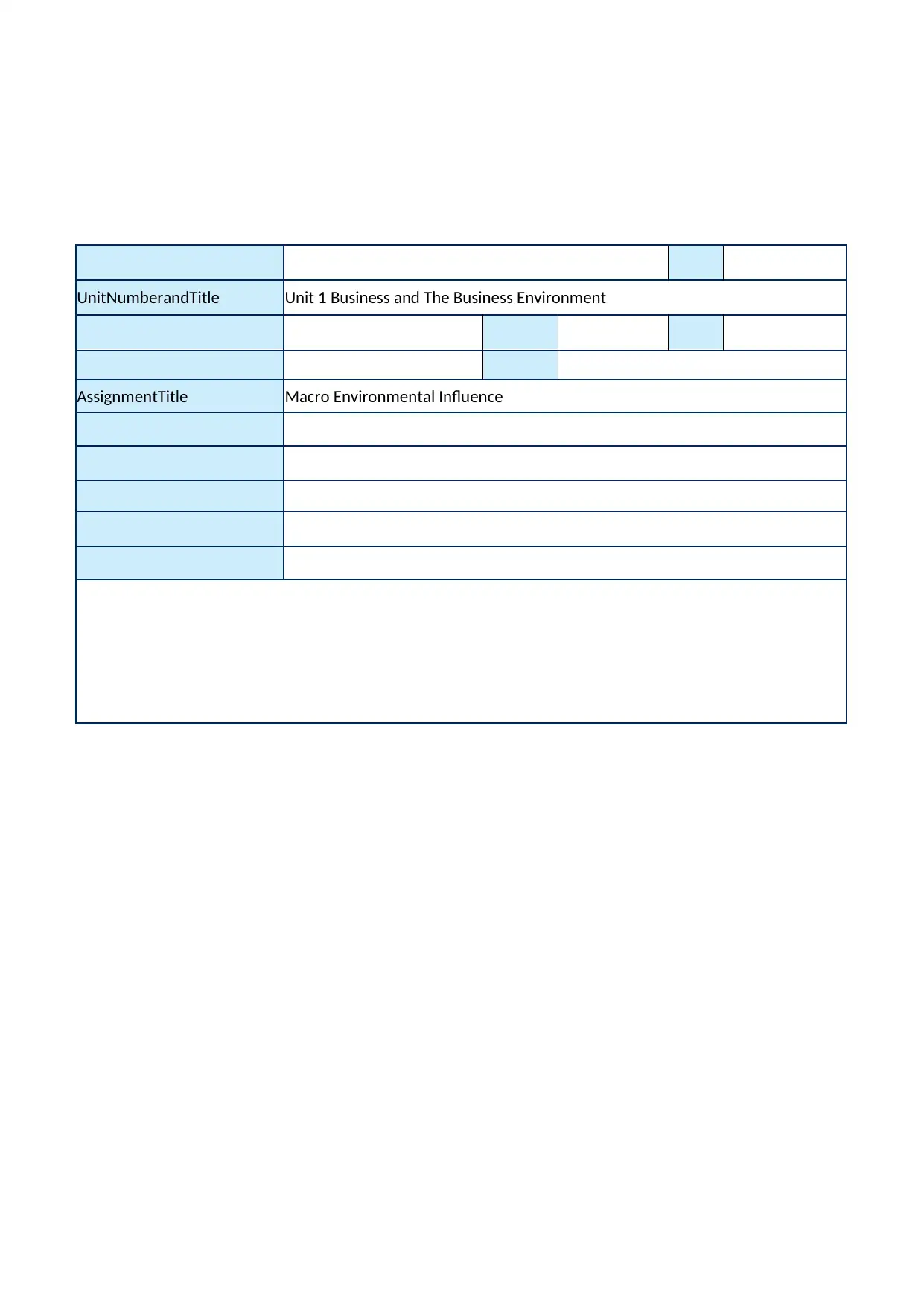
UnitNumberandTitle Unit 1 Business and The Business Environment
AssignmentTitle Macro Environmental Influence
AssignmentTitle Macro Environmental Influence
Paraphrase This Document
Need a fresh take? Get an instant paraphrase of this document with our AI Paraphraser
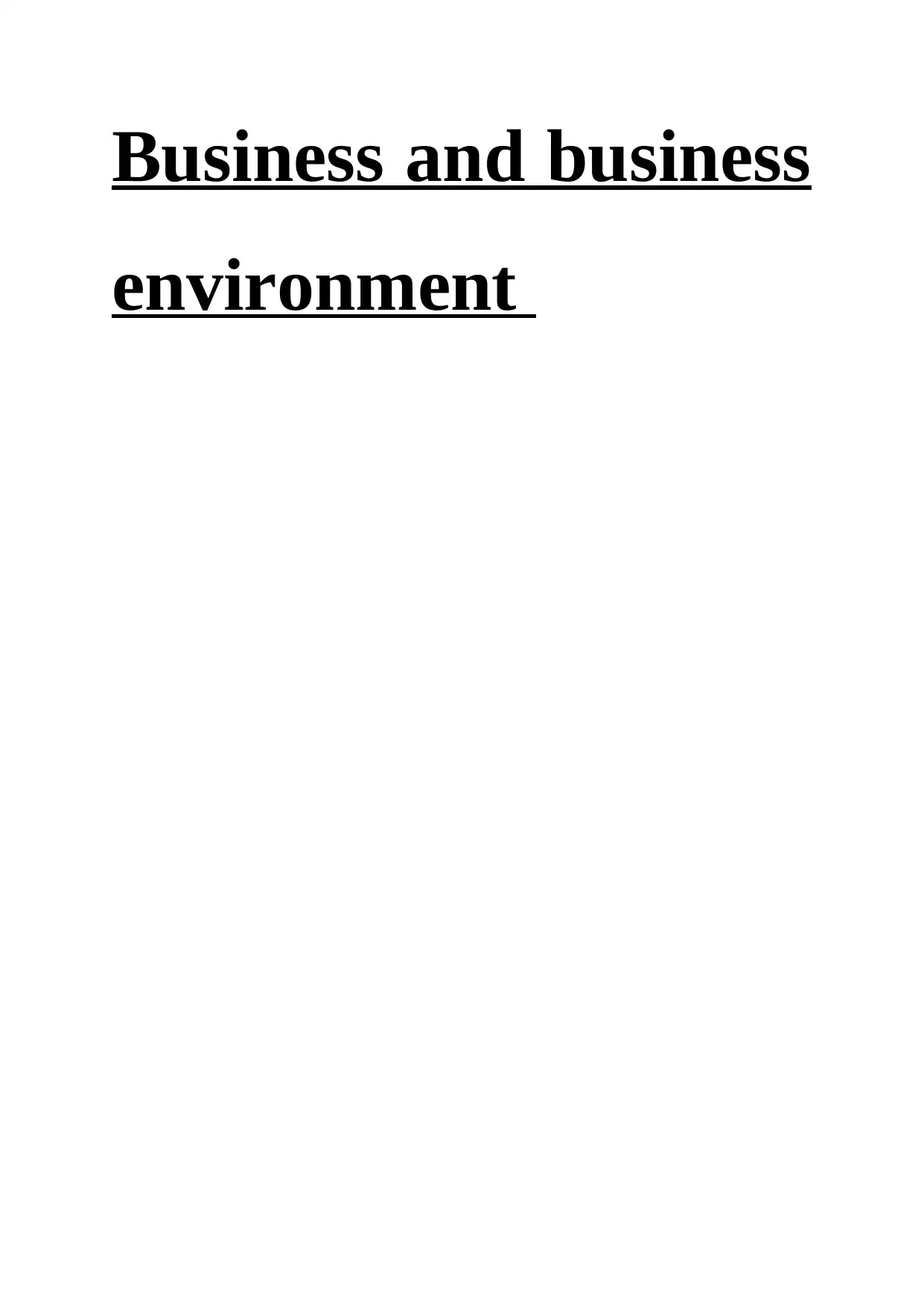
Business and business
environment
environment
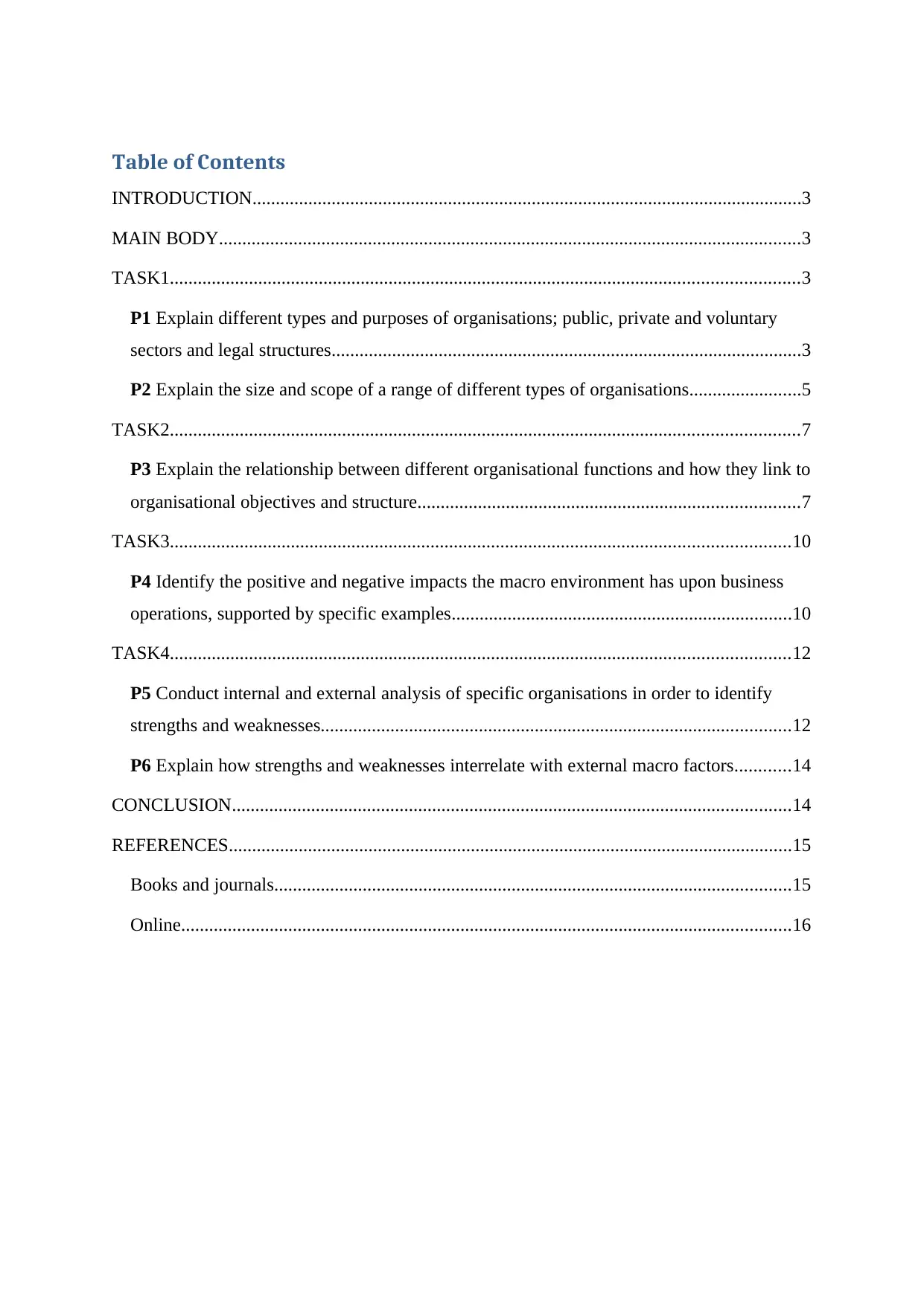
Table of Contents
INTRODUCTION......................................................................................................................3
MAIN BODY.............................................................................................................................3
TASK1.......................................................................................................................................3
P1 Explain different types and purposes of organisations; public, private and voluntary
sectors and legal structures.....................................................................................................3
P2 Explain the size and scope of a range of different types of organisations........................5
TASK2.......................................................................................................................................7
P3 Explain the relationship between different organisational functions and how they link to
organisational objectives and structure..................................................................................7
TASK3.....................................................................................................................................10
P4 Identify the positive and negative impacts the macro environment has upon business
operations, supported by specific examples.........................................................................10
TASK4.....................................................................................................................................12
P5 Conduct internal and external analysis of specific organisations in order to identify
strengths and weaknesses.....................................................................................................12
P6 Explain how strengths and weaknesses interrelate with external macro factors............14
CONCLUSION........................................................................................................................14
REFERENCES.........................................................................................................................15
Books and journals...............................................................................................................15
Online...................................................................................................................................16
INTRODUCTION......................................................................................................................3
MAIN BODY.............................................................................................................................3
TASK1.......................................................................................................................................3
P1 Explain different types and purposes of organisations; public, private and voluntary
sectors and legal structures.....................................................................................................3
P2 Explain the size and scope of a range of different types of organisations........................5
TASK2.......................................................................................................................................7
P3 Explain the relationship between different organisational functions and how they link to
organisational objectives and structure..................................................................................7
TASK3.....................................................................................................................................10
P4 Identify the positive and negative impacts the macro environment has upon business
operations, supported by specific examples.........................................................................10
TASK4.....................................................................................................................................12
P5 Conduct internal and external analysis of specific organisations in order to identify
strengths and weaknesses.....................................................................................................12
P6 Explain how strengths and weaknesses interrelate with external macro factors............14
CONCLUSION........................................................................................................................14
REFERENCES.........................................................................................................................15
Books and journals...............................................................................................................15
Online...................................................................................................................................16
⊘ This is a preview!⊘
Do you want full access?
Subscribe today to unlock all pages.

Trusted by 1+ million students worldwide
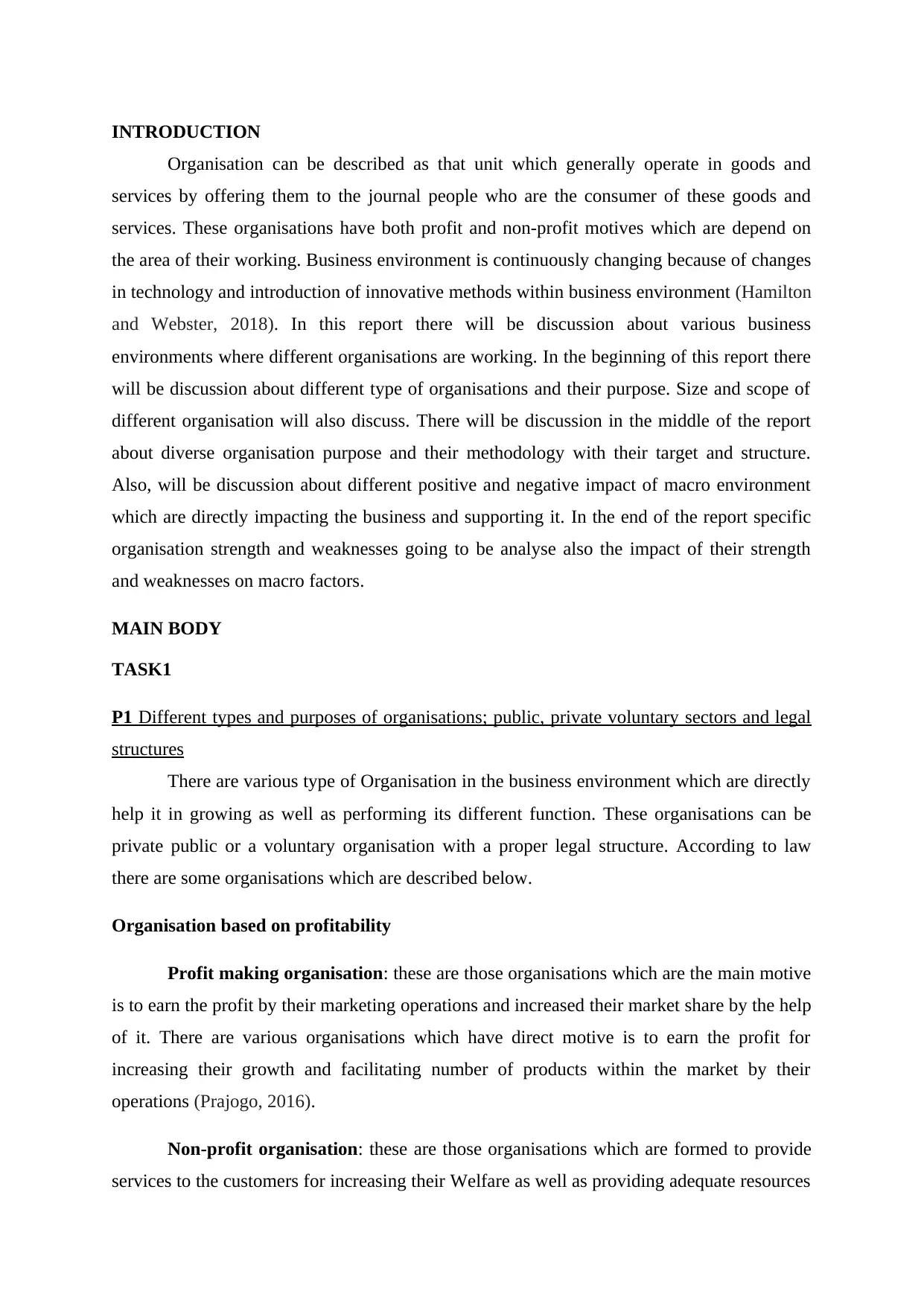
INTRODUCTION
Organisation can be described as that unit which generally operate in goods and
services by offering them to the journal people who are the consumer of these goods and
services. These organisations have both profit and non-profit motives which are depend on
the area of their working. Business environment is continuously changing because of changes
in technology and introduction of innovative methods within business environment (Hamilton
and Webster, 2018). In this report there will be discussion about various business
environments where different organisations are working. In the beginning of this report there
will be discussion about different type of organisations and their purpose. Size and scope of
different organisation will also discuss. There will be discussion in the middle of the report
about diverse organisation purpose and their methodology with their target and structure.
Also, will be discussion about different positive and negative impact of macro environment
which are directly impacting the business and supporting it. In the end of the report specific
organisation strength and weaknesses going to be analyse also the impact of their strength
and weaknesses on macro factors.
MAIN BODY
TASK1
P1 Different types and purposes of organisations; public, private voluntary sectors and legal
structures
There are various type of Organisation in the business environment which are directly
help it in growing as well as performing its different function. These organisations can be
private public or a voluntary organisation with a proper legal structure. According to law
there are some organisations which are described below.
Organisation based on profitability
Profit making organisation: these are those organisations which are the main motive
is to earn the profit by their marketing operations and increased their market share by the help
of it. There are various organisations which have direct motive is to earn the profit for
increasing their growth and facilitating number of products within the market by their
operations (Prajogo, 2016).
Non-profit organisation: these are those organisations which are formed to provide
services to the customers for increasing their Welfare as well as providing adequate resources
Organisation can be described as that unit which generally operate in goods and
services by offering them to the journal people who are the consumer of these goods and
services. These organisations have both profit and non-profit motives which are depend on
the area of their working. Business environment is continuously changing because of changes
in technology and introduction of innovative methods within business environment (Hamilton
and Webster, 2018). In this report there will be discussion about various business
environments where different organisations are working. In the beginning of this report there
will be discussion about different type of organisations and their purpose. Size and scope of
different organisation will also discuss. There will be discussion in the middle of the report
about diverse organisation purpose and their methodology with their target and structure.
Also, will be discussion about different positive and negative impact of macro environment
which are directly impacting the business and supporting it. In the end of the report specific
organisation strength and weaknesses going to be analyse also the impact of their strength
and weaknesses on macro factors.
MAIN BODY
TASK1
P1 Different types and purposes of organisations; public, private voluntary sectors and legal
structures
There are various type of Organisation in the business environment which are directly
help it in growing as well as performing its different function. These organisations can be
private public or a voluntary organisation with a proper legal structure. According to law
there are some organisations which are described below.
Organisation based on profitability
Profit making organisation: these are those organisations which are the main motive
is to earn the profit by their marketing operations and increased their market share by the help
of it. There are various organisations which have direct motive is to earn the profit for
increasing their growth and facilitating number of products within the market by their
operations (Prajogo, 2016).
Non-profit organisation: these are those organisations which are formed to provide
services to the customers for increasing their Welfare as well as providing adequate resources
Paraphrase This Document
Need a fresh take? Get an instant paraphrase of this document with our AI Paraphraser
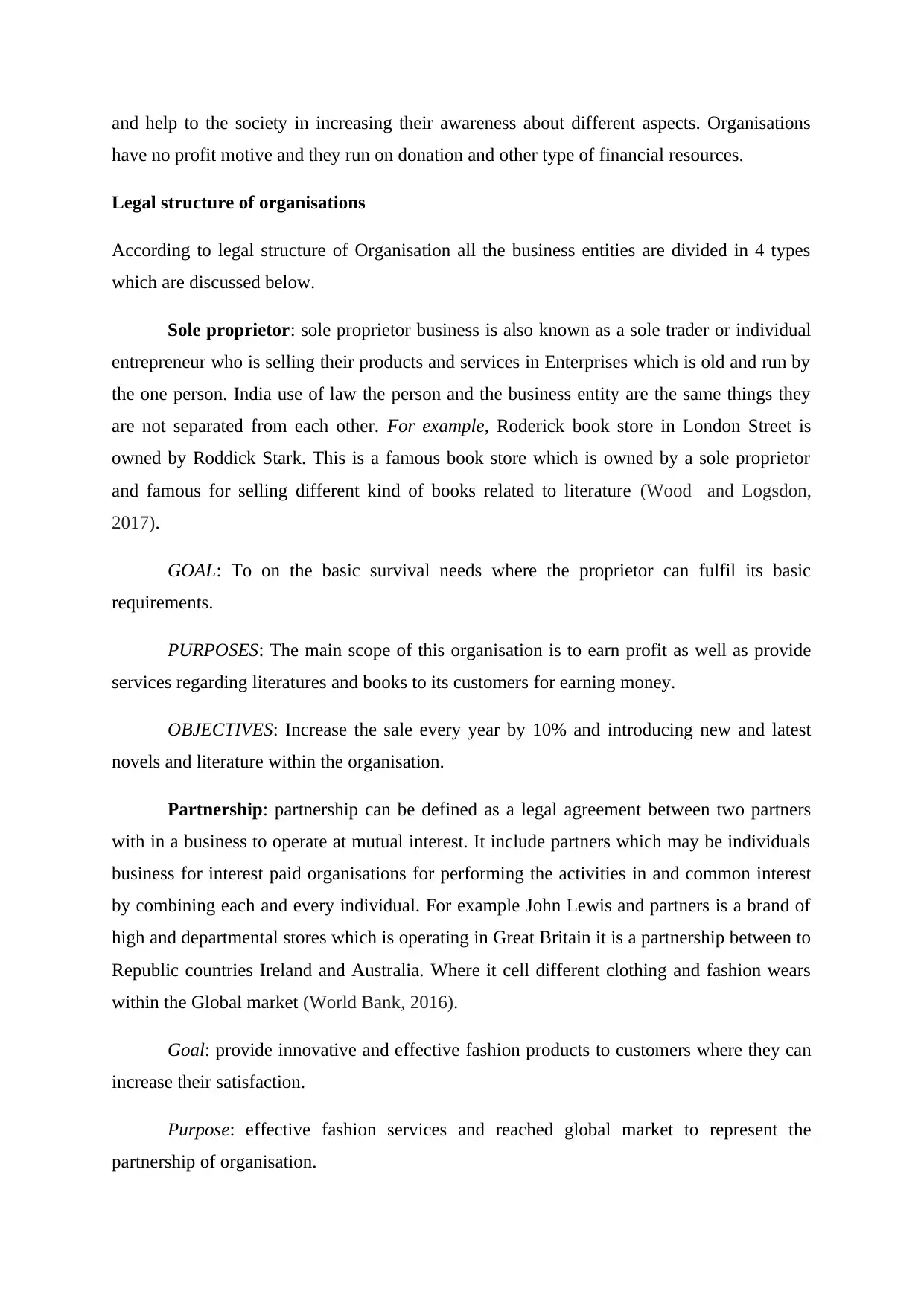
and help to the society in increasing their awareness about different aspects. Organisations
have no profit motive and they run on donation and other type of financial resources.
Legal structure of organisations
According to legal structure of Organisation all the business entities are divided in 4 types
which are discussed below.
Sole proprietor: sole proprietor business is also known as a sole trader or individual
entrepreneur who is selling their products and services in Enterprises which is old and run by
the one person. India use of law the person and the business entity are the same things they
are not separated from each other. For example, Roderick book store in London Street is
owned by Roddick Stark. This is a famous book store which is owned by a sole proprietor
and famous for selling different kind of books related to literature (Wood and Logsdon,
2017).
GOAL: To on the basic survival needs where the proprietor can fulfil its basic
requirements.
PURPOSES: The main scope of this organisation is to earn profit as well as provide
services regarding literatures and books to its customers for earning money.
OBJECTIVES: Increase the sale every year by 10% and introducing new and latest
novels and literature within the organisation.
Partnership: partnership can be defined as a legal agreement between two partners
with in a business to operate at mutual interest. It include partners which may be individuals
business for interest paid organisations for performing the activities in and common interest
by combining each and every individual. For example John Lewis and partners is a brand of
high and departmental stores which is operating in Great Britain it is a partnership between to
Republic countries Ireland and Australia. Where it cell different clothing and fashion wears
within the Global market (World Bank, 2016).
Goal: provide innovative and effective fashion products to customers where they can
increase their satisfaction.
Purpose: effective fashion services and reached global market to represent the
partnership of organisation.
have no profit motive and they run on donation and other type of financial resources.
Legal structure of organisations
According to legal structure of Organisation all the business entities are divided in 4 types
which are discussed below.
Sole proprietor: sole proprietor business is also known as a sole trader or individual
entrepreneur who is selling their products and services in Enterprises which is old and run by
the one person. India use of law the person and the business entity are the same things they
are not separated from each other. For example, Roderick book store in London Street is
owned by Roddick Stark. This is a famous book store which is owned by a sole proprietor
and famous for selling different kind of books related to literature (Wood and Logsdon,
2017).
GOAL: To on the basic survival needs where the proprietor can fulfil its basic
requirements.
PURPOSES: The main scope of this organisation is to earn profit as well as provide
services regarding literatures and books to its customers for earning money.
OBJECTIVES: Increase the sale every year by 10% and introducing new and latest
novels and literature within the organisation.
Partnership: partnership can be defined as a legal agreement between two partners
with in a business to operate at mutual interest. It include partners which may be individuals
business for interest paid organisations for performing the activities in and common interest
by combining each and every individual. For example John Lewis and partners is a brand of
high and departmental stores which is operating in Great Britain it is a partnership between to
Republic countries Ireland and Australia. Where it cell different clothing and fashion wears
within the Global market (World Bank, 2016).
Goal: provide innovative and effective fashion products to customers where they can
increase their satisfaction.
Purpose: effective fashion services and reached global market to represent the
partnership of organisation.
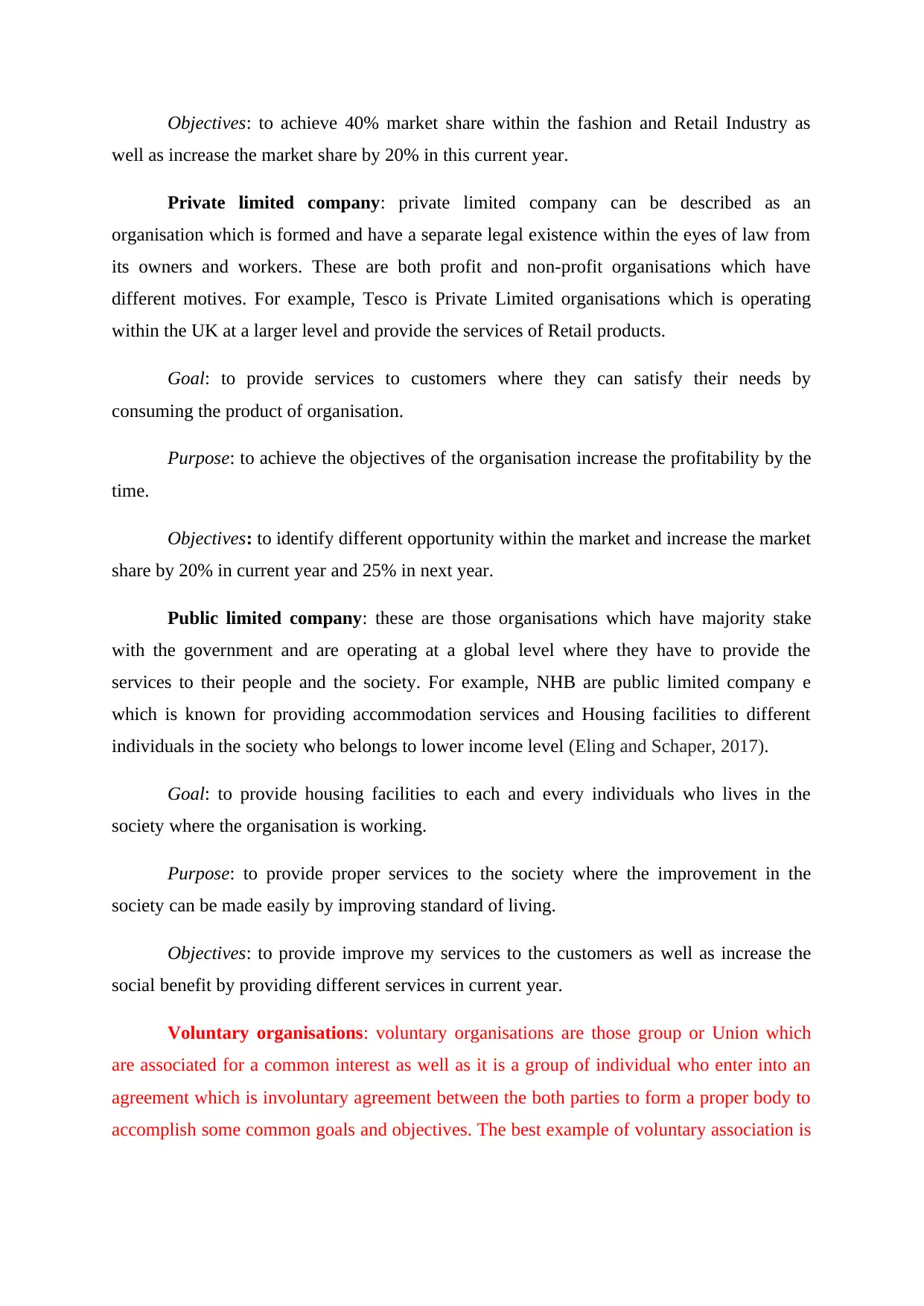
Objectives: to achieve 40% market share within the fashion and Retail Industry as
well as increase the market share by 20% in this current year.
Private limited company: private limited company can be described as an
organisation which is formed and have a separate legal existence within the eyes of law from
its owners and workers. These are both profit and non-profit organisations which have
different motives. For example, Tesco is Private Limited organisations which is operating
within the UK at a larger level and provide the services of Retail products.
Goal: to provide services to customers where they can satisfy their needs by
consuming the product of organisation.
Purpose: to achieve the objectives of the organisation increase the profitability by the
time.
Objectives: to identify different opportunity within the market and increase the market
share by 20% in current year and 25% in next year.
Public limited company: these are those organisations which have majority stake
with the government and are operating at a global level where they have to provide the
services to their people and the society. For example, NHB are public limited company e
which is known for providing accommodation services and Housing facilities to different
individuals in the society who belongs to lower income level (Eling and Schaper, 2017).
Goal: to provide housing facilities to each and every individuals who lives in the
society where the organisation is working.
Purpose: to provide proper services to the society where the improvement in the
society can be made easily by improving standard of living.
Objectives: to provide improve my services to the customers as well as increase the
social benefit by providing different services in current year.
Voluntary organisations: voluntary organisations are those group or Union which
are associated for a common interest as well as it is a group of individual who enter into an
agreement which is involuntary agreement between the both parties to form a proper body to
accomplish some common goals and objectives. The best example of voluntary association is
well as increase the market share by 20% in this current year.
Private limited company: private limited company can be described as an
organisation which is formed and have a separate legal existence within the eyes of law from
its owners and workers. These are both profit and non-profit organisations which have
different motives. For example, Tesco is Private Limited organisations which is operating
within the UK at a larger level and provide the services of Retail products.
Goal: to provide services to customers where they can satisfy their needs by
consuming the product of organisation.
Purpose: to achieve the objectives of the organisation increase the profitability by the
time.
Objectives: to identify different opportunity within the market and increase the market
share by 20% in current year and 25% in next year.
Public limited company: these are those organisations which have majority stake
with the government and are operating at a global level where they have to provide the
services to their people and the society. For example, NHB are public limited company e
which is known for providing accommodation services and Housing facilities to different
individuals in the society who belongs to lower income level (Eling and Schaper, 2017).
Goal: to provide housing facilities to each and every individuals who lives in the
society where the organisation is working.
Purpose: to provide proper services to the society where the improvement in the
society can be made easily by improving standard of living.
Objectives: to provide improve my services to the customers as well as increase the
social benefit by providing different services in current year.
Voluntary organisations: voluntary organisations are those group or Union which
are associated for a common interest as well as it is a group of individual who enter into an
agreement which is involuntary agreement between the both parties to form a proper body to
accomplish some common goals and objectives. The best example of voluntary association is
⊘ This is a preview!⊘
Do you want full access?
Subscribe today to unlock all pages.

Trusted by 1+ million students worldwide
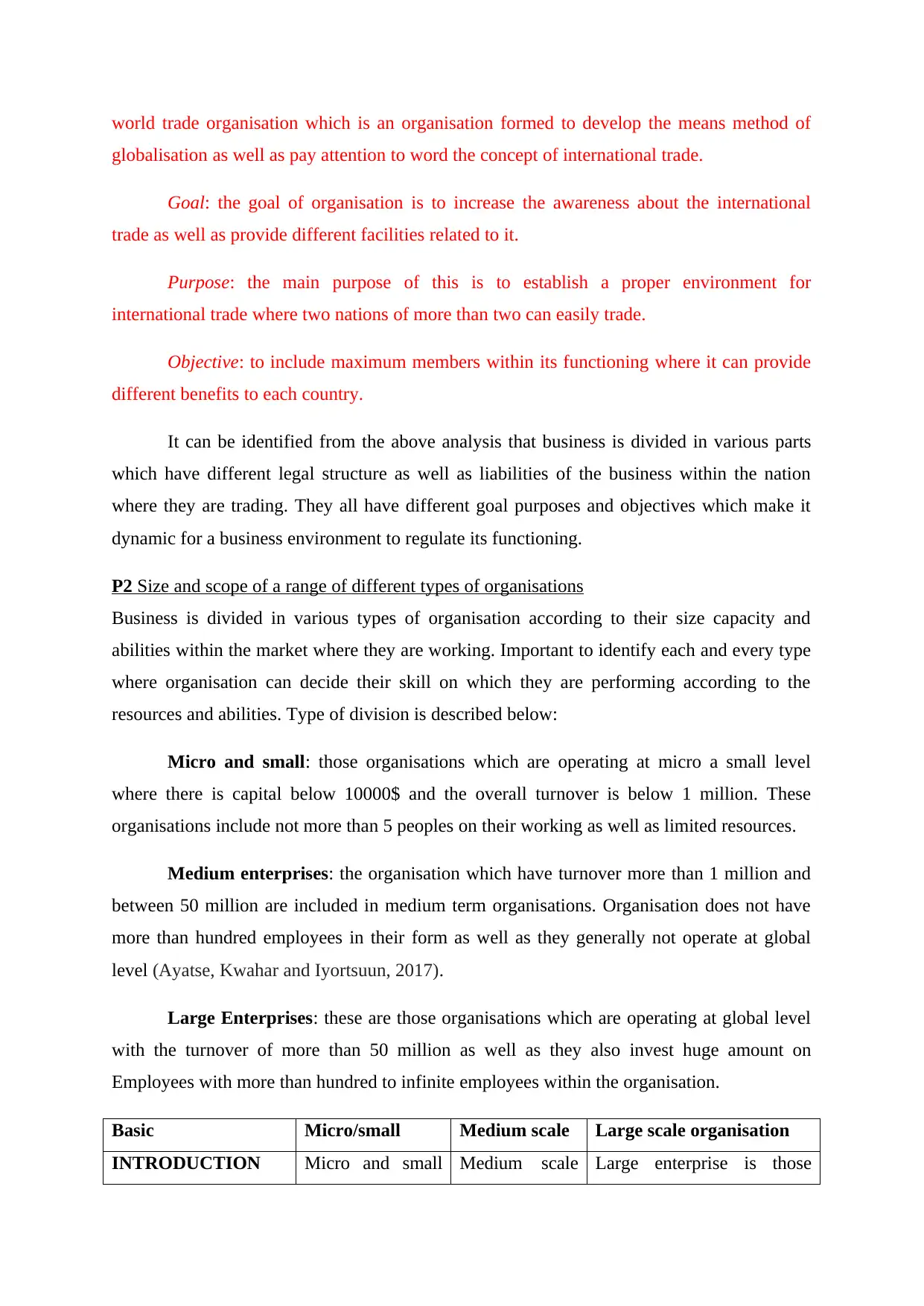
world trade organisation which is an organisation formed to develop the means method of
globalisation as well as pay attention to word the concept of international trade.
Goal: the goal of organisation is to increase the awareness about the international
trade as well as provide different facilities related to it.
Purpose: the main purpose of this is to establish a proper environment for
international trade where two nations of more than two can easily trade.
Objective: to include maximum members within its functioning where it can provide
different benefits to each country.
It can be identified from the above analysis that business is divided in various parts
which have different legal structure as well as liabilities of the business within the nation
where they are trading. They all have different goal purposes and objectives which make it
dynamic for a business environment to regulate its functioning.
P2 Size and scope of a range of different types of organisations
Business is divided in various types of organisation according to their size capacity and
abilities within the market where they are working. Important to identify each and every type
where organisation can decide their skill on which they are performing according to the
resources and abilities. Type of division is described below:
Micro and small: those organisations which are operating at micro a small level
where there is capital below 10000$ and the overall turnover is below 1 million. These
organisations include not more than 5 peoples on their working as well as limited resources.
Medium enterprises: the organisation which have turnover more than 1 million and
between 50 million are included in medium term organisations. Organisation does not have
more than hundred employees in their form as well as they generally not operate at global
level (Ayatse, Kwahar and Iyortsuun, 2017).
Large Enterprises: these are those organisations which are operating at global level
with the turnover of more than 50 million as well as they also invest huge amount on
Employees with more than hundred to infinite employees within the organisation.
Basic Micro/small Medium scale Large scale organisation
INTRODUCTION Micro and small Medium scale Large enterprise is those
globalisation as well as pay attention to word the concept of international trade.
Goal: the goal of organisation is to increase the awareness about the international
trade as well as provide different facilities related to it.
Purpose: the main purpose of this is to establish a proper environment for
international trade where two nations of more than two can easily trade.
Objective: to include maximum members within its functioning where it can provide
different benefits to each country.
It can be identified from the above analysis that business is divided in various parts
which have different legal structure as well as liabilities of the business within the nation
where they are trading. They all have different goal purposes and objectives which make it
dynamic for a business environment to regulate its functioning.
P2 Size and scope of a range of different types of organisations
Business is divided in various types of organisation according to their size capacity and
abilities within the market where they are working. Important to identify each and every type
where organisation can decide their skill on which they are performing according to the
resources and abilities. Type of division is described below:
Micro and small: those organisations which are operating at micro a small level
where there is capital below 10000$ and the overall turnover is below 1 million. These
organisations include not more than 5 peoples on their working as well as limited resources.
Medium enterprises: the organisation which have turnover more than 1 million and
between 50 million are included in medium term organisations. Organisation does not have
more than hundred employees in their form as well as they generally not operate at global
level (Ayatse, Kwahar and Iyortsuun, 2017).
Large Enterprises: these are those organisations which are operating at global level
with the turnover of more than 50 million as well as they also invest huge amount on
Employees with more than hundred to infinite employees within the organisation.
Basic Micro/small Medium scale Large scale organisation
INTRODUCTION Micro and small Medium scale Large enterprise is those
Paraphrase This Document
Need a fresh take? Get an instant paraphrase of this document with our AI Paraphraser
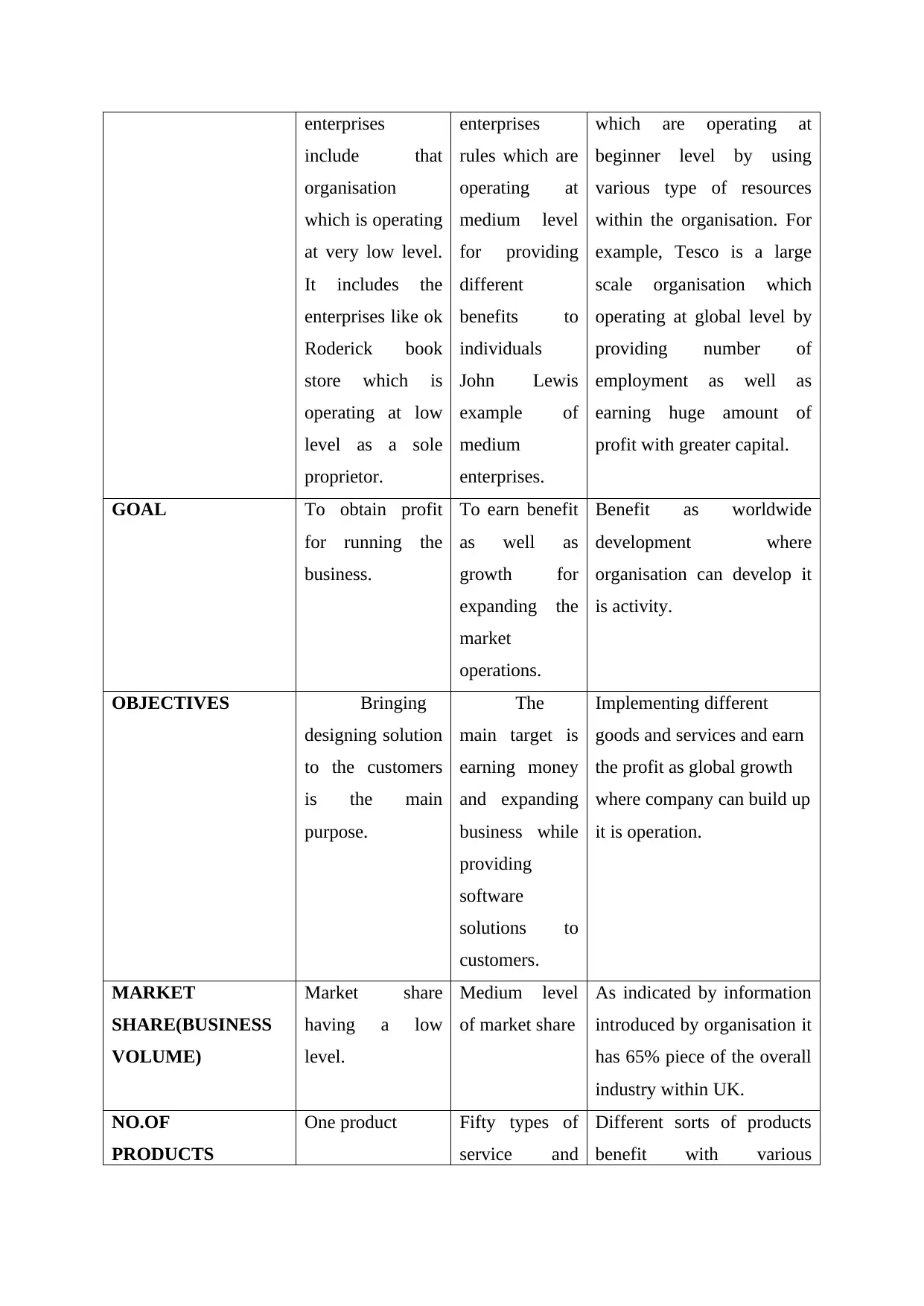
enterprises
include that
organisation
which is operating
at very low level.
It includes the
enterprises like ok
Roderick book
store which is
operating at low
level as a sole
proprietor.
enterprises
rules which are
operating at
medium level
for providing
different
benefits to
individuals
John Lewis
example of
medium
enterprises.
which are operating at
beginner level by using
various type of resources
within the organisation. For
example, Tesco is a large
scale organisation which
operating at global level by
providing number of
employment as well as
earning huge amount of
profit with greater capital.
GOAL To obtain profit
for running the
business.
To earn benefit
as well as
growth for
expanding the
market
operations.
Benefit as worldwide
development where
organisation can develop it
is activity.
OBJECTIVES Bringing
designing solution
to the customers
is the main
purpose.
The
main target is
earning money
and expanding
business while
providing
software
solutions to
customers.
Implementing different
goods and services and earn
the profit as global growth
where company can build up
it is operation.
MARKET
SHARE(BUSINESS
VOLUME)
Market share
having a low
level.
Medium level
of market share
As indicated by information
introduced by organisation it
has 65% piece of the overall
industry within UK.
NO.OF
PRODUCTS
One product Fifty types of
service and
Different sorts of products
benefit with various
include that
organisation
which is operating
at very low level.
It includes the
enterprises like ok
Roderick book
store which is
operating at low
level as a sole
proprietor.
enterprises
rules which are
operating at
medium level
for providing
different
benefits to
individuals
John Lewis
example of
medium
enterprises.
which are operating at
beginner level by using
various type of resources
within the organisation. For
example, Tesco is a large
scale organisation which
operating at global level by
providing number of
employment as well as
earning huge amount of
profit with greater capital.
GOAL To obtain profit
for running the
business.
To earn benefit
as well as
growth for
expanding the
market
operations.
Benefit as worldwide
development where
organisation can develop it
is activity.
OBJECTIVES Bringing
designing solution
to the customers
is the main
purpose.
The
main target is
earning money
and expanding
business while
providing
software
solutions to
customers.
Implementing different
goods and services and earn
the profit as global growth
where company can build up
it is operation.
MARKET
SHARE(BUSINESS
VOLUME)
Market share
having a low
level.
Medium level
of market share
As indicated by information
introduced by organisation it
has 65% piece of the overall
industry within UK.
NO.OF
PRODUCTS
One product Fifty types of
service and
Different sorts of products
benefit with various
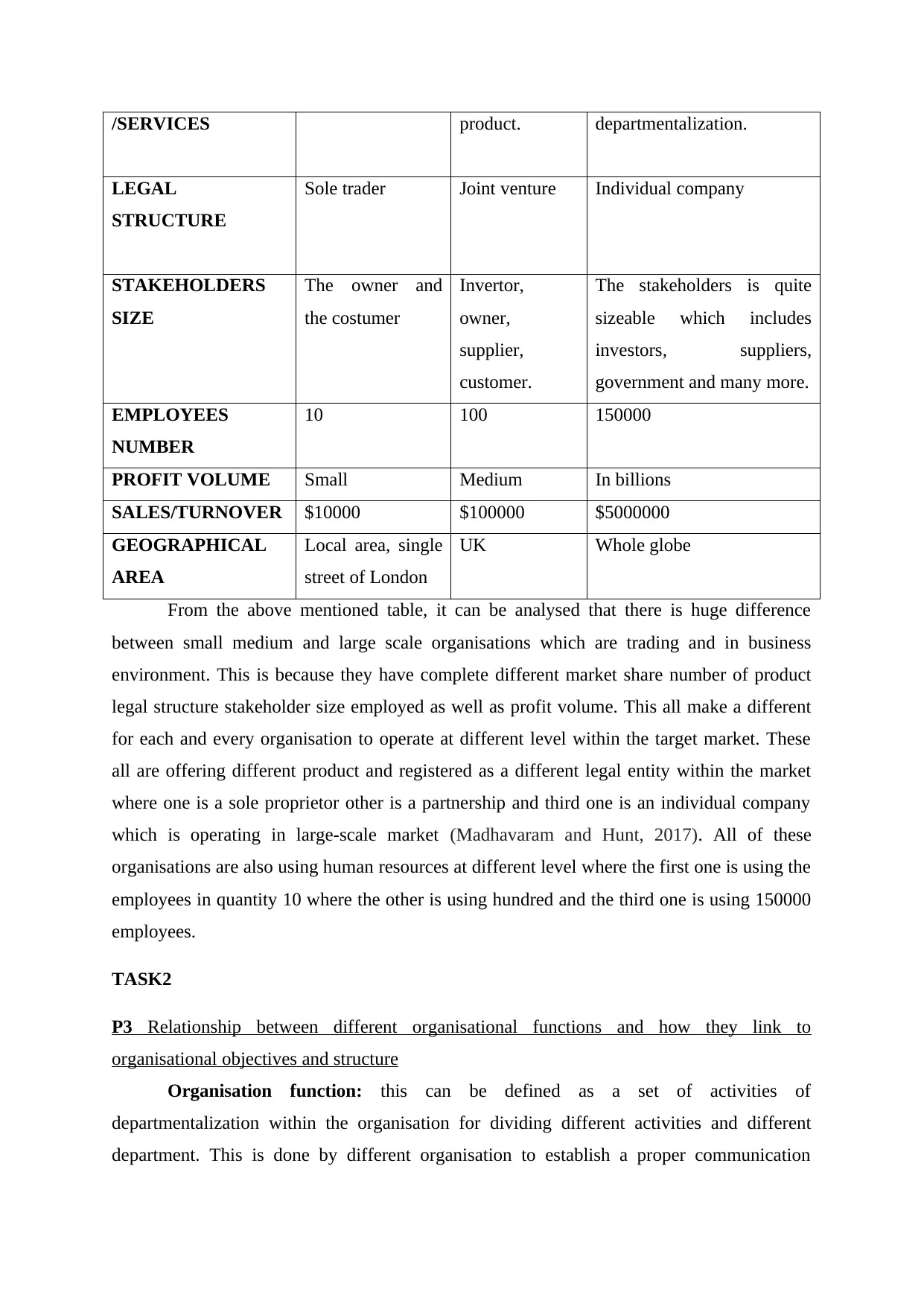
/SERVICES product. departmentalization.
LEGAL
STRUCTURE
Sole trader Joint venture Individual company
STAKEHOLDERS
SIZE
The owner and
the costumer
Invertor,
owner,
supplier,
customer.
The stakeholders is quite
sizeable which includes
investors, suppliers,
government and many more.
EMPLOYEES
NUMBER
10 100 150000
PROFIT VOLUME Small Medium In billions
SALES/TURNOVER $10000 $100000 $5000000
GEOGRAPHICAL
AREA
Local area, single
street of London
UK Whole globe
From the above mentioned table, it can be analysed that there is huge difference
between small medium and large scale organisations which are trading and in business
environment. This is because they have complete different market share number of product
legal structure stakeholder size employed as well as profit volume. This all make a different
for each and every organisation to operate at different level within the target market. These
all are offering different product and registered as a different legal entity within the market
where one is a sole proprietor other is a partnership and third one is an individual company
which is operating in large-scale market (Madhavaram and Hunt, 2017). All of these
organisations are also using human resources at different level where the first one is using the
employees in quantity 10 where the other is using hundred and the third one is using 150000
employees.
TASK2
P3 Relationship between different organisational functions and how they link to
organisational objectives and structure
Organisation function: this can be defined as a set of activities of
departmentalization within the organisation for dividing different activities and different
department. This is done by different organisation to establish a proper communication
LEGAL
STRUCTURE
Sole trader Joint venture Individual company
STAKEHOLDERS
SIZE
The owner and
the costumer
Invertor,
owner,
supplier,
customer.
The stakeholders is quite
sizeable which includes
investors, suppliers,
government and many more.
EMPLOYEES
NUMBER
10 100 150000
PROFIT VOLUME Small Medium In billions
SALES/TURNOVER $10000 $100000 $5000000
GEOGRAPHICAL
AREA
Local area, single
street of London
UK Whole globe
From the above mentioned table, it can be analysed that there is huge difference
between small medium and large scale organisations which are trading and in business
environment. This is because they have complete different market share number of product
legal structure stakeholder size employed as well as profit volume. This all make a different
for each and every organisation to operate at different level within the target market. These
all are offering different product and registered as a different legal entity within the market
where one is a sole proprietor other is a partnership and third one is an individual company
which is operating in large-scale market (Madhavaram and Hunt, 2017). All of these
organisations are also using human resources at different level where the first one is using the
employees in quantity 10 where the other is using hundred and the third one is using 150000
employees.
TASK2
P3 Relationship between different organisational functions and how they link to
organisational objectives and structure
Organisation function: this can be defined as a set of activities of
departmentalization within the organisation for dividing different activities and different
department. This is done by different organisation to establish a proper communication
⊘ This is a preview!⊘
Do you want full access?
Subscribe today to unlock all pages.

Trusted by 1+ million students worldwide
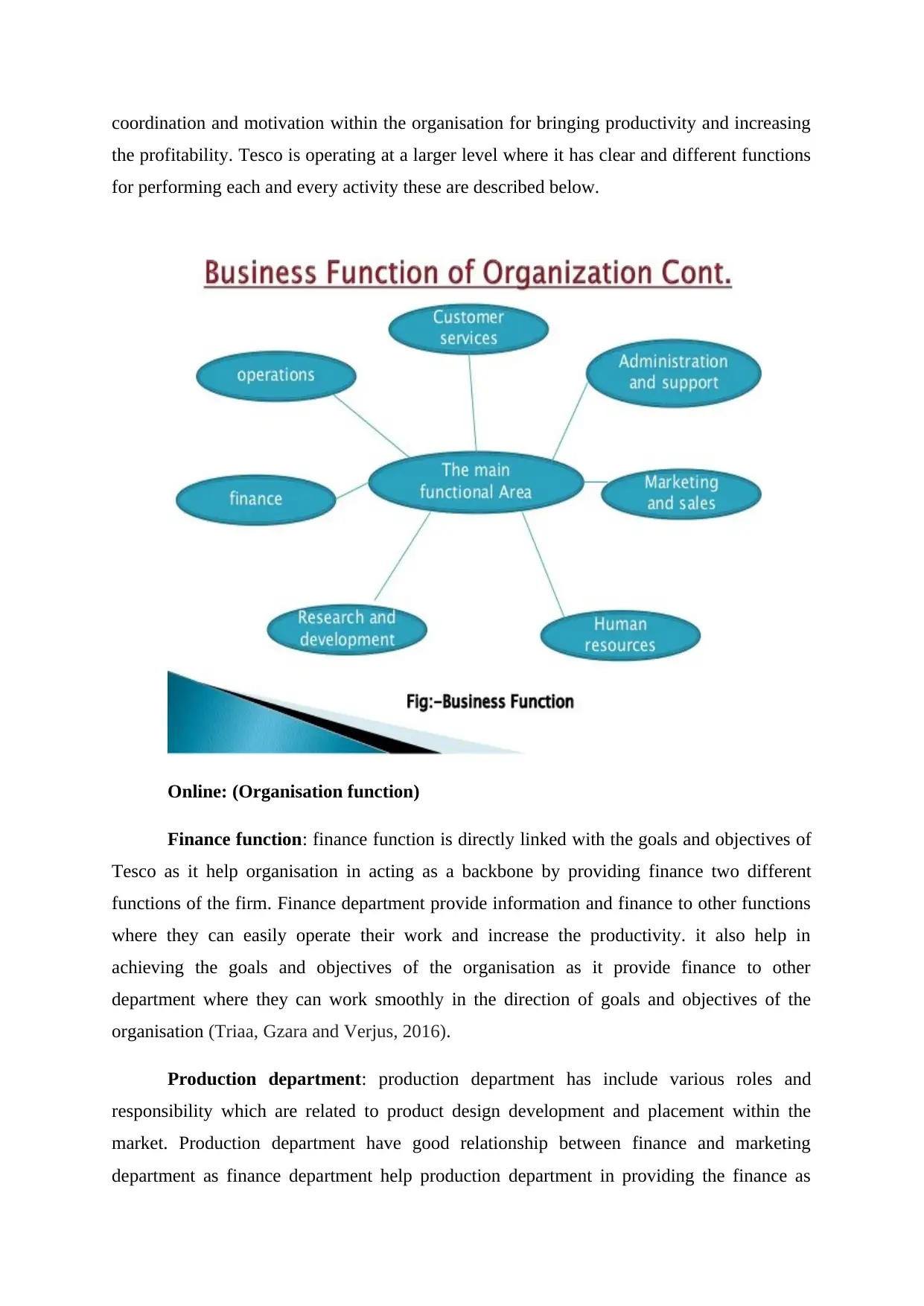
coordination and motivation within the organisation for bringing productivity and increasing
the profitability. Tesco is operating at a larger level where it has clear and different functions
for performing each and every activity these are described below.
Online: (Organisation function)
Finance function: finance function is directly linked with the goals and objectives of
Tesco as it help organisation in acting as a backbone by providing finance two different
functions of the firm. Finance department provide information and finance to other functions
where they can easily operate their work and increase the productivity. it also help in
achieving the goals and objectives of the organisation as it provide finance to other
department where they can work smoothly in the direction of goals and objectives of the
organisation (Triaa, Gzara and Verjus, 2016).
Production department: production department has include various roles and
responsibility which are related to product design development and placement within the
market. Production department have good relationship between finance and marketing
department as finance department help production department in providing the finance as
the profitability. Tesco is operating at a larger level where it has clear and different functions
for performing each and every activity these are described below.
Online: (Organisation function)
Finance function: finance function is directly linked with the goals and objectives of
Tesco as it help organisation in acting as a backbone by providing finance two different
functions of the firm. Finance department provide information and finance to other functions
where they can easily operate their work and increase the productivity. it also help in
achieving the goals and objectives of the organisation as it provide finance to other
department where they can work smoothly in the direction of goals and objectives of the
organisation (Triaa, Gzara and Verjus, 2016).
Production department: production department has include various roles and
responsibility which are related to product design development and placement within the
market. Production department have good relationship between finance and marketing
department as finance department help production department in providing the finance as
Paraphrase This Document
Need a fresh take? Get an instant paraphrase of this document with our AI Paraphraser
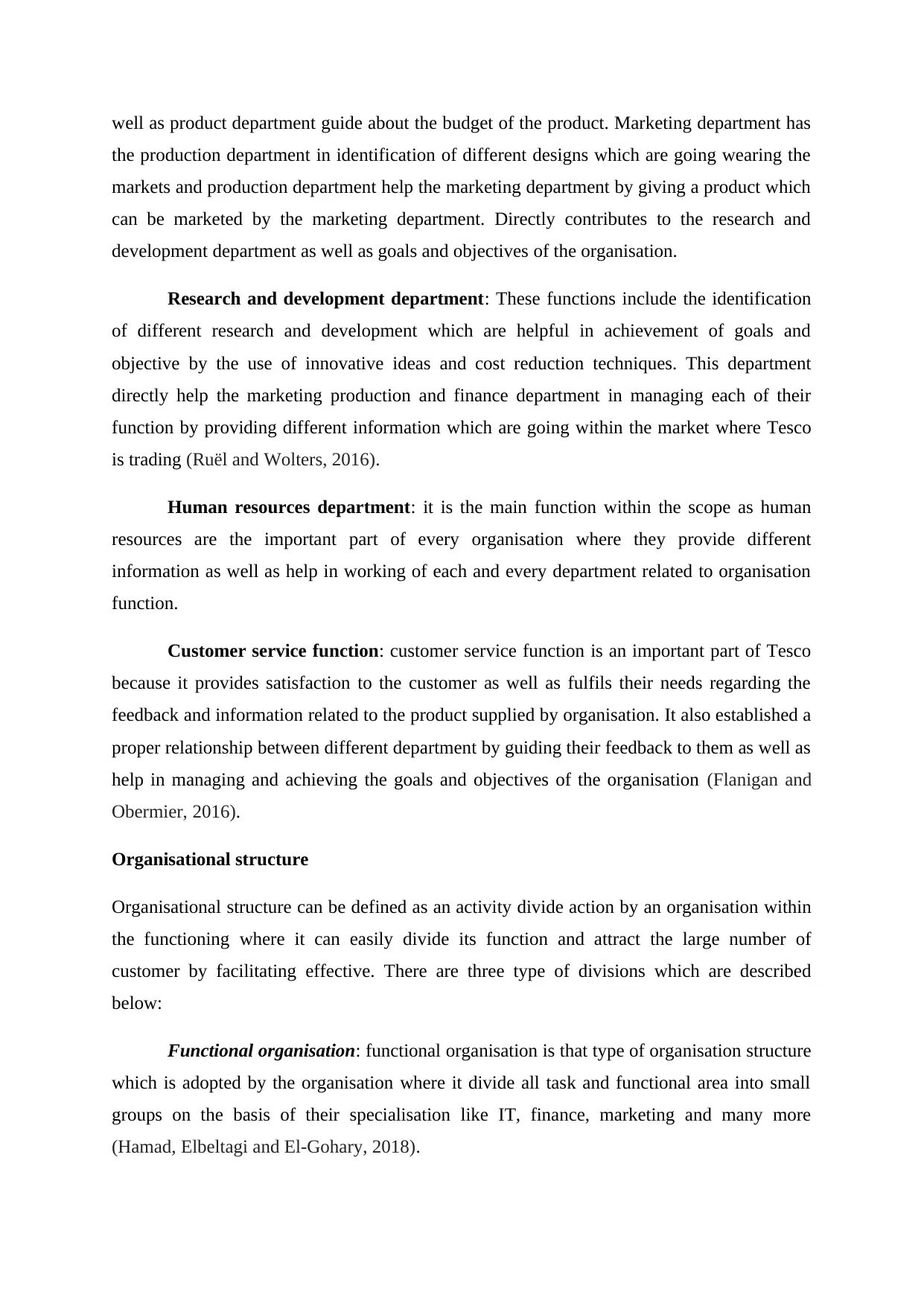
well as product department guide about the budget of the product. Marketing department has
the production department in identification of different designs which are going wearing the
markets and production department help the marketing department by giving a product which
can be marketed by the marketing department. Directly contributes to the research and
development department as well as goals and objectives of the organisation.
Research and development department: These functions include the identification
of different research and development which are helpful in achievement of goals and
objective by the use of innovative ideas and cost reduction techniques. This department
directly help the marketing production and finance department in managing each of their
function by providing different information which are going within the market where Tesco
is trading (Ruël and Wolters, 2016).
Human resources department: it is the main function within the scope as human
resources are the important part of every organisation where they provide different
information as well as help in working of each and every department related to organisation
function.
Customer service function: customer service function is an important part of Tesco
because it provides satisfaction to the customer as well as fulfils their needs regarding the
feedback and information related to the product supplied by organisation. It also established a
proper relationship between different department by guiding their feedback to them as well as
help in managing and achieving the goals and objectives of the organisation (Flanigan and
Obermier, 2016).
Organisational structure
Organisational structure can be defined as an activity divide action by an organisation within
the functioning where it can easily divide its function and attract the large number of
customer by facilitating effective. There are three type of divisions which are described
below:
Functional organisation: functional organisation is that type of organisation structure
which is adopted by the organisation where it divide all task and functional area into small
groups on the basis of their specialisation like IT, finance, marketing and many more
(Hamad, Elbeltagi and El‐Gohary, 2018).
the production department in identification of different designs which are going wearing the
markets and production department help the marketing department by giving a product which
can be marketed by the marketing department. Directly contributes to the research and
development department as well as goals and objectives of the organisation.
Research and development department: These functions include the identification
of different research and development which are helpful in achievement of goals and
objective by the use of innovative ideas and cost reduction techniques. This department
directly help the marketing production and finance department in managing each of their
function by providing different information which are going within the market where Tesco
is trading (Ruël and Wolters, 2016).
Human resources department: it is the main function within the scope as human
resources are the important part of every organisation where they provide different
information as well as help in working of each and every department related to organisation
function.
Customer service function: customer service function is an important part of Tesco
because it provides satisfaction to the customer as well as fulfils their needs regarding the
feedback and information related to the product supplied by organisation. It also established a
proper relationship between different department by guiding their feedback to them as well as
help in managing and achieving the goals and objectives of the organisation (Flanigan and
Obermier, 2016).
Organisational structure
Organisational structure can be defined as an activity divide action by an organisation within
the functioning where it can easily divide its function and attract the large number of
customer by facilitating effective. There are three type of divisions which are described
below:
Functional organisation: functional organisation is that type of organisation structure
which is adopted by the organisation where it divide all task and functional area into small
groups on the basis of their specialisation like IT, finance, marketing and many more
(Hamad, Elbeltagi and El‐Gohary, 2018).
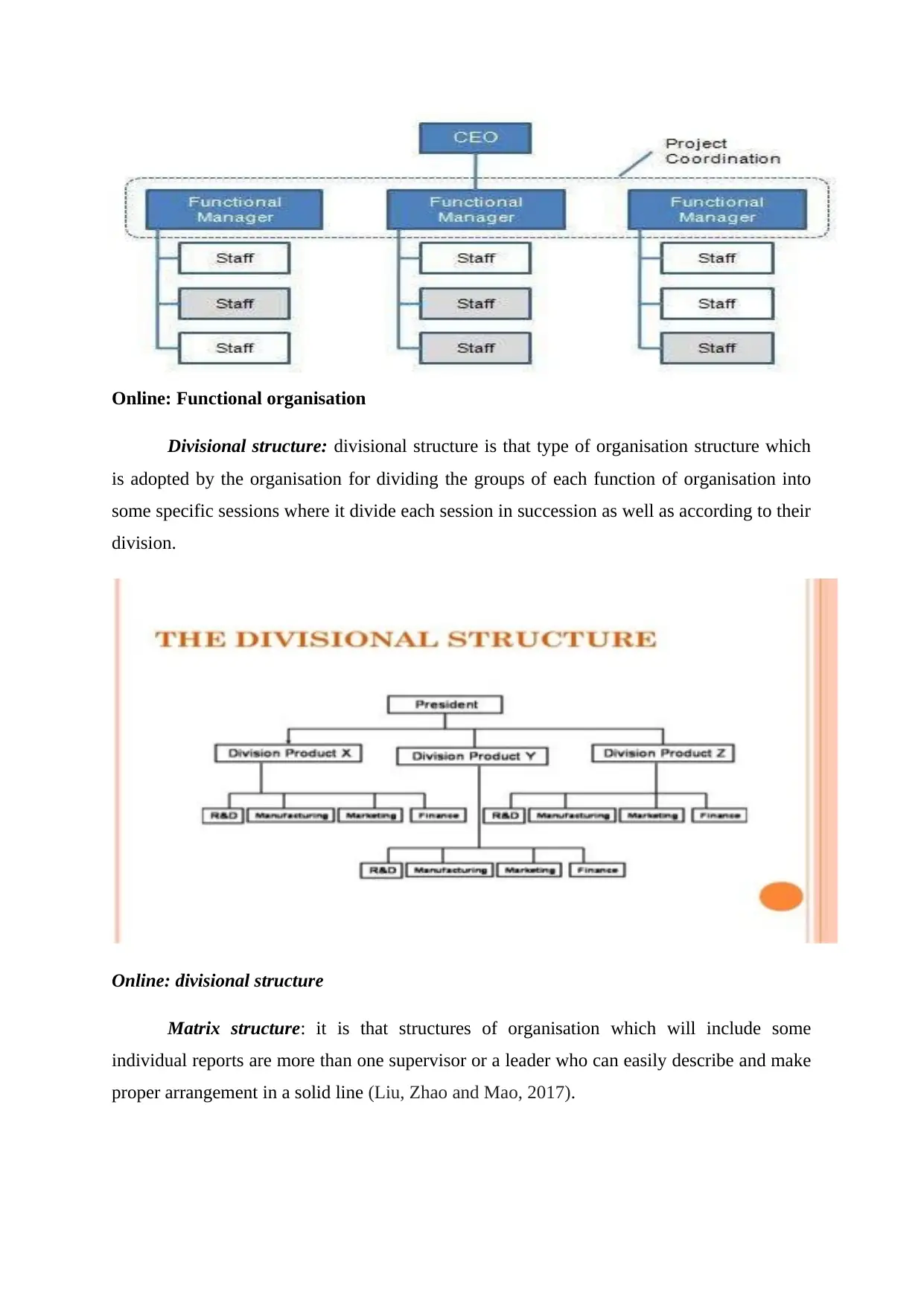
Online: Functional organisation
Divisional structure: divisional structure is that type of organisation structure which
is adopted by the organisation for dividing the groups of each function of organisation into
some specific sessions where it divide each session in succession as well as according to their
division.
Online: divisional structure
Matrix structure: it is that structures of organisation which will include some
individual reports are more than one supervisor or a leader who can easily describe and make
proper arrangement in a solid line (Liu, Zhao and Mao, 2017).
Divisional structure: divisional structure is that type of organisation structure which
is adopted by the organisation for dividing the groups of each function of organisation into
some specific sessions where it divide each session in succession as well as according to their
division.
Online: divisional structure
Matrix structure: it is that structures of organisation which will include some
individual reports are more than one supervisor or a leader who can easily describe and make
proper arrangement in a solid line (Liu, Zhao and Mao, 2017).
⊘ This is a preview!⊘
Do you want full access?
Subscribe today to unlock all pages.

Trusted by 1+ million students worldwide
1 out of 22
Related Documents
Your All-in-One AI-Powered Toolkit for Academic Success.
+13062052269
info@desklib.com
Available 24*7 on WhatsApp / Email
![[object Object]](/_next/static/media/star-bottom.7253800d.svg)
Unlock your academic potential
Copyright © 2020–2025 A2Z Services. All Rights Reserved. Developed and managed by ZUCOL.





